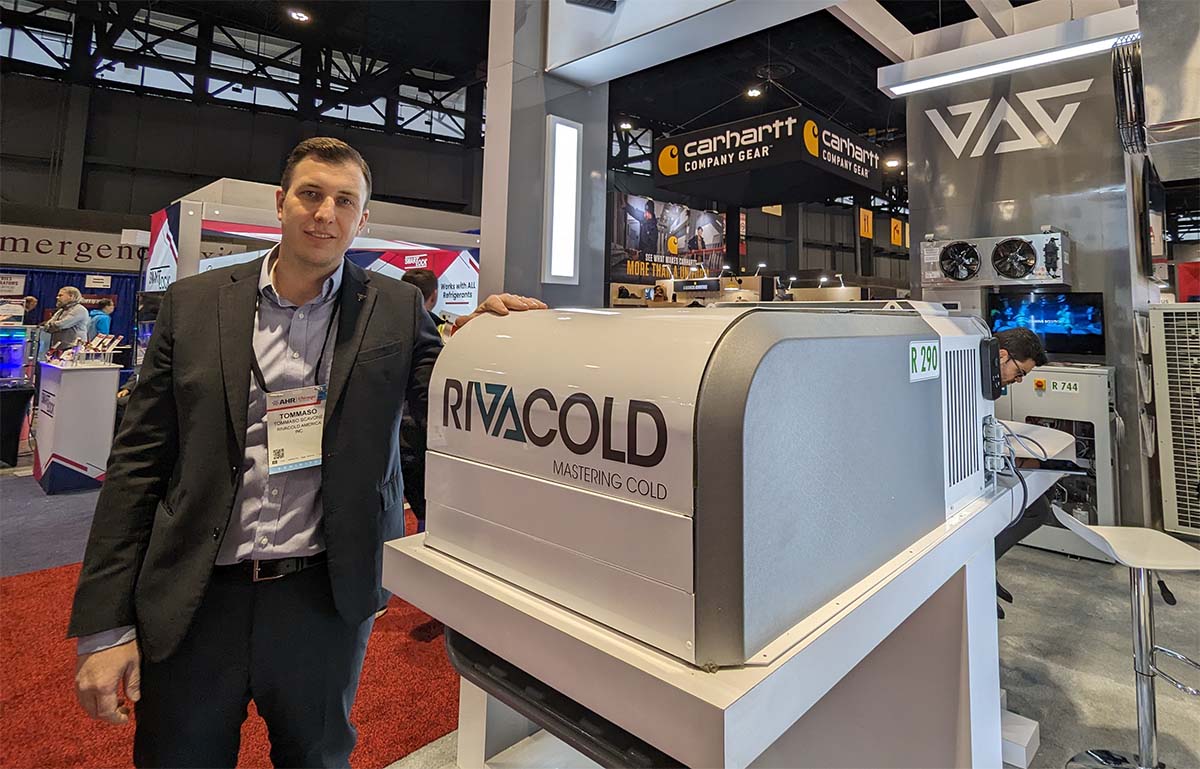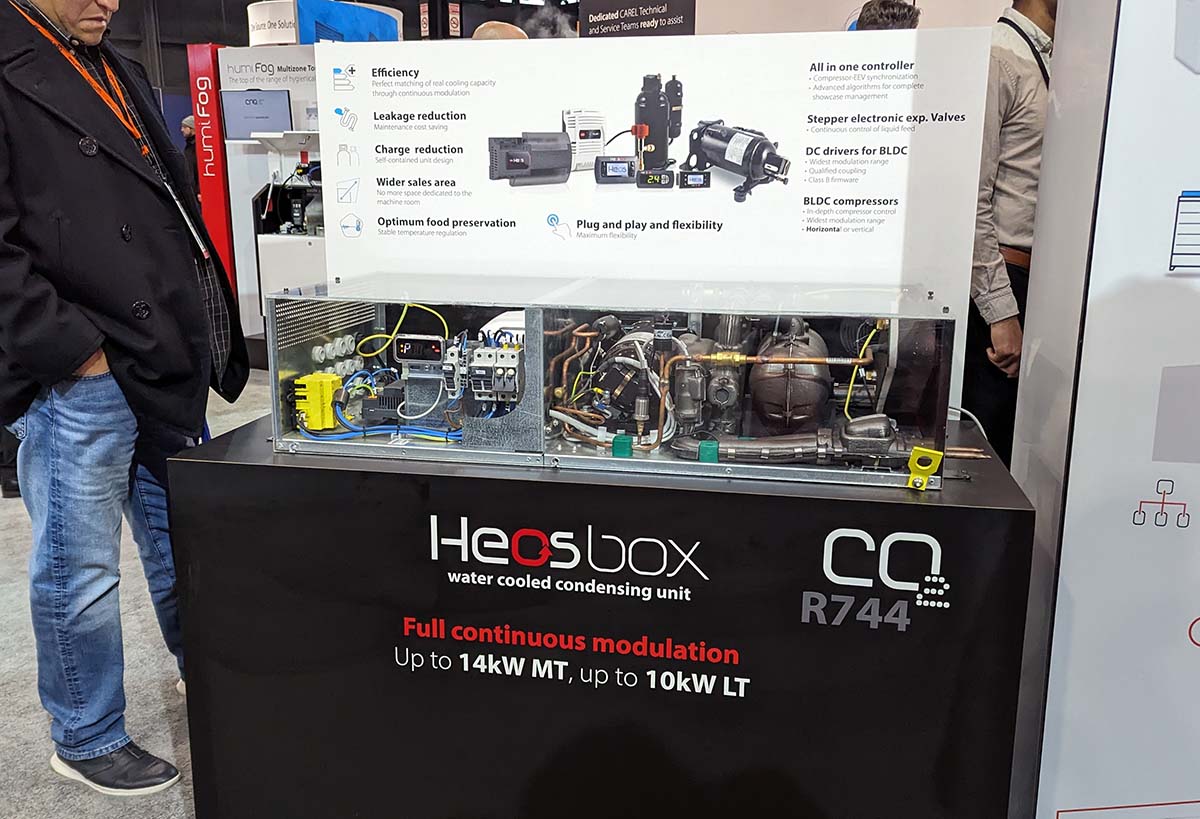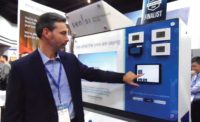head of sales and marketing for refrigeration in North America
Carel
Tens of thousands of HVACR contractors and industry professionals gathered at McCormick Place in Chicago in January for the three-day AHR Expo. The annual event gave manufacturers the opportunity to show off their latest equipment and components, which included new condensing units, controls, components, and other solutions designed to meet the needs of the commercial refrigeration market.
CO2 Condensing Units
Rivacold exhibited a brand-new line of transcritical CO2 condensing units for medium- and low-temperature refrigeration applications, designed for lineups of wall display cases, islands, cabinets, counters, and walk-ins of various sizes or combinations. With capacities up to 140,000 Btuh with a single unit, the MHX/MH2X line is a perfect match for restaurants, convenience stores, cold storage, and supermarkets of any size, said Tommaso Scavone, sales manager NAR at Rivacold America.
Also on display was the Monoblock BEST, variable-speed, R-290, air-cooled, packaged system, which is a plug-and-play solution for walk-in coolers and freezers.

R-290 SOLUTION: Tommaso Scavone pointed out the benefits of Rivacold’s Monoblock BEST, which uses R-290 and is a plug-n-play solution for walk-in coolers and freezers. (Staff photo)
“Revolutionary electronics and integrated connectivity system make this future-proof and game-changing product aesthetically appealing, functional, and digitally innovative,” said Scavone. “BEST design minimizes installation time and costs and maximizes storage space as never before. Smart controls offer a safe and reliable product with all the comfort of managing and monitoring the systems from a smartphone.”
These two product lines were specifically designed to offer modular and compact solutions with redundancy options, easy retrofits and remodels, and extreme flexibility when adding new refrigeration loads to existing stores — benefits that can be challenging or impossible to achieve with the use of a traditional multi-compressor rack concept, said Scavone. They also offer a starting point for end-users looking to gradually transition to a natural refrigerant solution rather than converting an entire store at one time.
“The use of a natural refrigerant like CO2 (GWP=1) and propane (GWP=3) makes these products extremely sustainable by reducing the total equivalent warming impact (TEWI) by 33% compared to a standard HFC system,” said Scavone. “This guarantees the end user a future-proof solution in terms of regulations, as well as a leading image in the market in terms of advanced technology and green refrigeration adoption. In addition, the variable-speed technology offers superior food preservation through cooling capacity control that eliminates the dangerous temperature extremes seen from on-off systems, as well as significant energy savings, translating to lower utility bills.”
In addition to the increasing adoption of natural refrigerants in food retail and smaller industrial applications, Rivacold has observed a rising interest in modular solutions. According to Scavone, end users seeking modular solutions are looking for greater flexibility in terms of store layout modification, adding loads to current designs, and creating redundancy and independency from a single centralized remote system.
“Rivacold is well prepared with a wide range of green, efficient, and modular solutions to face this demand,” said Scavone. “It is a continuous investment of ours, and we are offering to the market now the widest and most complete range of natural refrigerant solutions, responding to all the different needs of this green evolution.”
Refrigeration Systems
Heat Transfer Products Group (HTPG) displayed its Packaged Refrigeration System, which is designed for food service and food retail coolers and freezers. According to Raleigh Thompson, director of product strategy and marketing at HTPG, the innovative design of the Packaged Refrigeration System prioritizes enhancing performance, energy efficiency, and capacity to cater to the requirements of many types of commercial businesses.
“These units optimize product quality by minimizing temperature fluctuations and maximizing energy efficiency, resulting in reduced compressor runtime,” he said. “Designed for easy installation and serviceability, the units are equipped with lift-off hinges and panels, along with multiple drain-out points for either a boil-out drain pan or PVC connection.”
HTPG also highlighted the EcoNet Enabled Refrigeration System, which was developed in conjunction with Rheem Manufacturing. Thompson noted that this system builds on the success, reliability, and efficiency of Rheem’s EcoNet technology and brings it to the commercial refrigeration market.
“The EcoNet technology saves energy in refrigeration systems through precise superheat and space temperature control, fan cycling, and controlling defrost cycles based on compressor runtime,” he said. “EcoNet-enabled unit coolers can be configured to work on a single or dual evaporator coils and can be used with a condensing unit in single and multiple evaporator installations as a group. It is currently available as a configurable option on all HTPG walk-in unit cooler families.”
Thompson noted that both of these products feature some unique benefits. For example, the EcoNet and electronic expansion valve technology improves product quality by reducing temperature fluctuations and providing centralized system data access for service technicians. The Packaged Refrigeration System offers flexibility with a wide range of applications and options, maximizing service space, service ports, and component accessibility.
With the Command Center addition, Thompson said that both products can connect to local wireless internet, enabling contractors and technicians to receive early notifications about system issues via SMS or email; diagnose problems remotely using system data; and potentially reduce on-site visits by purchasing parts based on system performance insights.
Thompson emphasized that the shift towards products utilizing lower-GWP refrigerants stands out as a significant industry trend. In responding to this trend, he noted that HTPG is developing a full range of products to support the market during the migration to low-GWP and natural refrigerants. Education is another trend — and opportunity — this year, he said.
“The biggest opportunity for our industry in 2024 can be summed up in one word: education,” he said. “The commercial refrigeration industry has more changes occurring over the next few years than it has ever seen before. Being accurately informed on these changes, with current information, will not only prepare the industry for these new requirements, but can also serve as a competitive advantage to contractors.”
Control Solutions
As a global manufacturer of control solutions for natural refrigerants, Carel launched several new products at the AHR Expo that are designed to help food retail customers transition to low-GWP refrigerants, said Giacomo Favari, head of sales and marketing for refrigeration in North America at Carel.
“Our technology makes it easy to manage complex applications such as transcritical CO2 systems, because all our new controllers contain our most advanced control algorithms, developed with our years of experience with CO2 applications in Europe and other regions,” he said. “Moreover, our new generation of control solutions is equipped with built-in Bluetooth connectivity, simplifying interactions with refrigeration equipment for quick diagnostics and troubleshooting. Field technicians can use Carel’s smartphone apps to share default parameter settings, reducing the time required to solve issues in the field.”
One of the control solutions that Carel displayed was the µRack CO2, which is an electronic controller specifically designed to manage condensing units and compact rack systems operating with CO2. This new controller expands the company’s product portfolio with a very flexible and compact solution, said Favari.
“µRack CO2 can also operate as a stand-alone driver for the HPV (high-pressure valve) and the FGBV (flash gas bypass valve) of any transcritical CO2 system, so it’s possible to install it in any rack for new installations and retrofit projects,” said Favari. “As with all our new controllers, µRack CO2 utilizes wireless Bluetooth technology, simplifying the interaction with the equipment and improving serviceability.”
The company also unveiled the iJW refrigeration controller, aimed at streamlining setup for replacements and new installations. It features Bluetooth for control via Carel's smartphone app, Applica, simplifying startup with an automated configuration "wizard." Once configured, the app displays wiring diagrams and facilitates manual testing of all inputs and outputs for swift system commissioning.
“iJW is extremely flexible, helping distributors reduce SKUs, because a single model can replace virtually any Carel and third-party controller installed in the field,” said Favari. “Remote monitoring is also available through CAREL’s new cloud monitoring platform RED Control, enabling remote asset management through a single-access online portal.”

CONDENSING UNIT: CAREL’s Heos box CO2 is a compact, subcritical, CO2 condensing unit designed for water-loop systems. (Staff photo)
Finally, Carel showcased the Heos box CO2, a compact, subcritical, CO2 condensing unit designed for water-loop systems. It offers easy installation and wired or wireless connectivity options such as Ethernet and Bluetooth. The unit allows customers to switch to low-GWP refrigerants like CO2, which results in benefits such as reduced refrigerant charge, store layout flexibility, low maintenance costs, energy efficiency, and product temperature stability, said Favari.
“We see an increased interest in low-GWP refrigerants driven by the latest regulations, and while there is still some uncertainty in the market on which type of refrigerant is most suitable for each application and capacity range, clearly CO2, A2Ls, and A3s will all play a significant role soon,” said Favari. “Our goal is to provide the market with the most advanced technologies to support the rollout of high-efficiency solutions based on the adoption of these low-GWP refrigerants.”






Report Abusive Comment